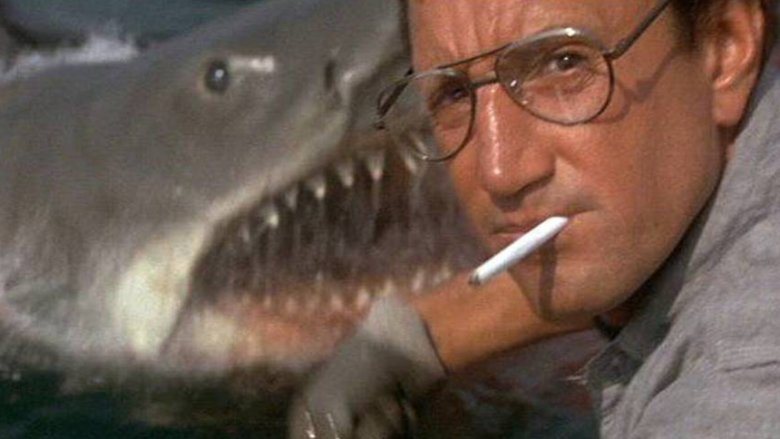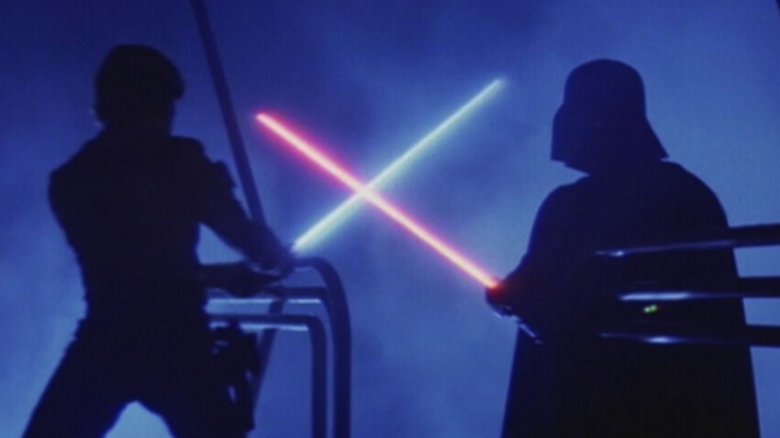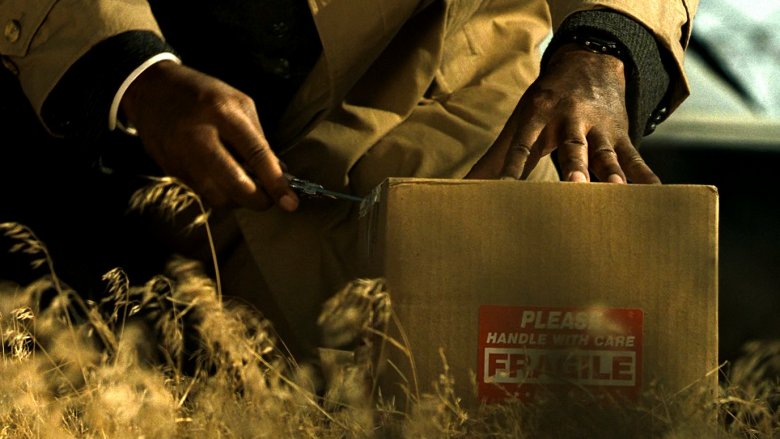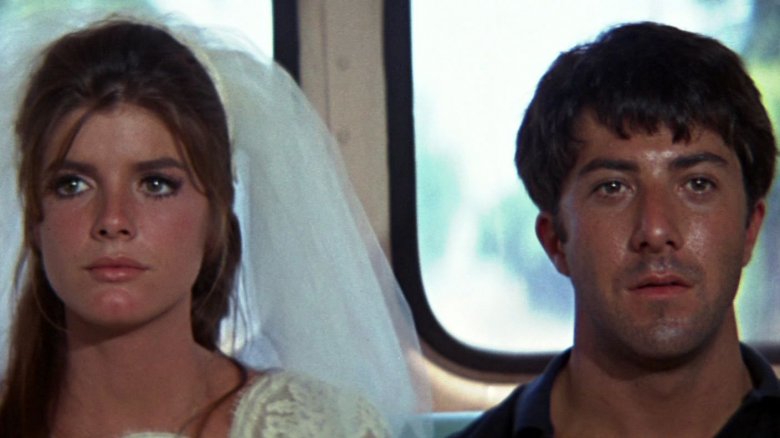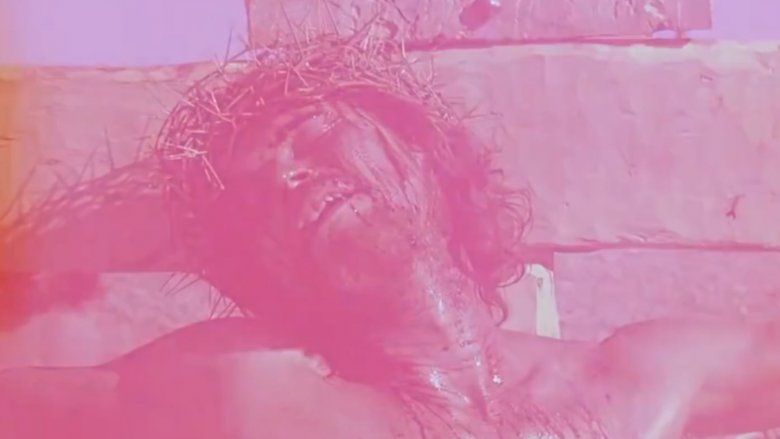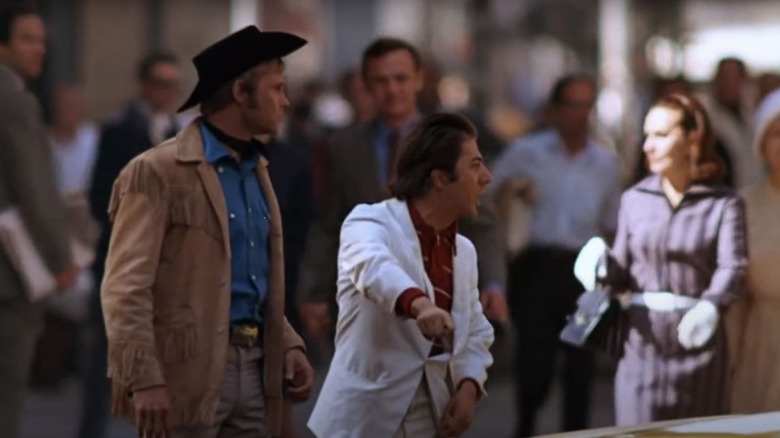Mistakes That Led To Classic Movie Scenes
Movies are a testament to the power and efficiency of micromanagement. Whether it's a big-budget blockbuster or a penny-pinching independent film, filmmakers simply have to plan out every last detail beforehand. Shooting locations have to be scouted, actors need to know exactly when to be on set with their lines memorized, and cinematographers must know how they want all the shots of the movie to be captured. If all goes well, the project stays on schedule — and, more importantly, on budget. There just isn't a lot of room for error, or improvisation.
However, accidents do occasionally happen on movie sets. Most of the time, when something goes wrong — a script problem, a faulty piece of equipment, an egregiously misplaced prop — the director just yells cut, the crew takes the time to fix whatever needs fixing, and filming resumes at the earliest possible time. But sometimes, those accidents are serendipitous — in fact, in a few cases, they've led to some of film's most memorable and special moments. Here are some behind-the-scenes mistakes that led to classic movie scenes.
Use the feedback, Luke
In an interview included on the Star Wars Trilogy: The Definitive Collection box set (via FilmSound), Star Wars sound designer Ben Burtt detailed how he created the indelible soundscape of those films, including how he came up with the way Darth Vader would sound, Chewbacca's growls, and what he used to build the unique "whoosh" of lightsabers.
Based on Ralph McQuarrie's concept art, Burtt "could kind of hear the sound in my head," and to that end, he recorded the hum of a movie projector — but it lacked the "buzzy sort of sparkling sound" he wanted. Then one day he found that missing element, completely by chance. Burtt said he was carrying a microphone across a room in a studio and passed a muted TV. The mic "picked up a transmission from the television set" and produced a loud buzz. Burtt recorded the buzzing feedback and combined it with the sound of the movie projector, creating "the basic lightsaber tone."
Thinking inside the box
Throughout Se7en, detectives Mills (Brad Pitt) and Somerset (Morgan Freeman), pursue "John Doe" (Kevin Spacey), a madman who kills according to the "Seven Deadly Sins": lust, gluttony, greed, sloth, pride, envy, and wrath. He's caught after five; the other two play out in the film's climax. John Doe endures Mills' wrath — a fatal gunshot — after Mills receives his wife's head in a box, which John Doe decapitated out of envy for Mills' life. It's a truly disturbing sequence.
Andrew Kevin Walker's Se7en script had floated around Hollywood for years — and gone through more than a dozen rewrites — before it landed at New Line Cinema with director David Fincher. "I read it, and got to the end, with the head in the box," Fincher related at a British Film institute event (via The Guardian). Then he called Walker to praise his work, appreciative of how he'd avoided police movie clichés like the "chase across town and the guy driving on sidewalks to get to the woman, who's drawing a bath while the serial killer sneaks in the back window."
Walker told Fincher that he'd mistakenly read the first draft of Se7en; he sent over the most recent version, which was full of the clichés that Fincher had dissed. Fincher approached an executive at New Line, who told him that he could make Se7en the way he wanted...if he started shooting as soon as possible before anyone else at the studio could slow him down.
Three men, a baby, and a ghost
As popular as it was in 1987 — it was the highest-grossing movie of the year — Three Men and a Baby hasn't aged all that well. With dads now much more willingly participating in child-rearing, the idea of three bachelors unable to change a diaper or quiet a fussy baby seems archaic and pathetic, not funny. The one scene from Three Men and a Baby that's truly endured is the one that spawned an urban legend.
Supposedly, the ghost of a child or teenager — who reportedly died in the house where the movie was filmed — can be spotted peeking from behind a curtain. (Look for it at 0:43 in the embedded video.) The myth persists despite its thorough debunking. Ted Danson plays an actor in the movie, and in an earlier scene, the audience sees a professional cardboard cutout of him. That standee got stashed behind a curtain, and when another scene was filmed, it's partially visible behind a wispy curtain. And that's your teen ghost. (Furthermore, a boy couldn't have died in the house where Three Men and a Baby was filmed, because it was shot on a sound stage.)
You're gonna need a perfect catchphrase
Jaws had a lot of production troubles, such as a barge that carried lights, camera, and craft services and had to be steadied by a boat that was dangerously too weak for the job. Screenwriter Carl Gottlieb — who stayed on the movie's watery set for four months to do rewrites — told The Hollywood Reporter that producers Richard Zanuck and David Brown were too stingy to spring for a bigger one, despite multiple crew members telling the two, "You're gonna need a bigger boat."
Gottlieb said that the line "became a catchphrase for anytime anything went wrong" on set. "If lunch was late or the swells were rocking the camera, someone would say, 'You're gonna need a bigger boat.'" Star Roy Schneider (Brody) improvised the line a few different times, but the one that got left in the movie was clearly the best. It's delivered right after Brody (and the audience) sees the terrifying titular shark up close and personal, and realizes just how huge it is.
Forget it, Jake, that's not how Chinatown was supposed to end
After all the stylish cinematography and the 1930s cars and costumes, the one thing about Chinatown that most people remember is the jaw-dropping final line. As cop Jake Gittes (Jack Nicholson) watches Noah Cross (John Huston), a powerful figure guilty of murder (among other things) walk away, another detective (Joe Mantell) quips, "Forget it, Jake, it's Chinatown." It's terse, shocking, and sums up a big message of this Roman Polanski film — that people with high status can get away with anything. It's also not how the movie was supposed to end, at least not according to the film's screenwriter, Robert Towne. He wanted a "happy" ending, with Evelyn Cross Mulwray (Faye Dunaway) killing Cross — her father, and the father of her daughter, Katherine.
Polanski couldn't hear any of that — he needed the villain to win. Producer Robert Evans sided with Polanski, so he got his way: Evelyn dies, Cross lives, and he strolls away with Katherine. As for that final line of summation, Polanski jotted down some notes on the night he needed to film the scene, handed them off to the actors, and told them to "fashion it" to the way their characters talked. They winged it, and it worked. (Towne later said that Polanski "was right about the end.")
How to create an awkward silence for the ages
The ending of The Graduate is extremely famous and often parodied. The Simpsons, Family Guy, UHF, and Wayne's World 2 all sent up the finale of the 1967 film, in which Benjamin (Dustin Hoffman) interrupts the wedding of his one true love Elaine (Katharine Ross) and whisks her away; they hop a bus to evade angry friends and family. The romance and excitement seemingly fade as Ben and Elaine sit on the bus and silently wonder, "Well, now what?"
The shooting draft of Buck Henry's screenplay ends differently. Ben and Elaine board the bus and hold hands while the camera lingers on all the upset people back at the church. Ben and Elaine's resulting mutual ennui was only filmed because nobody on set called "cut." According to film historian Bobbie O'Steen on a special feature for the Criterion Collection edition of The Graduate, director Mike Nichols wasn't around to supervise the bus scene, so he asked film editor Sam O'Steen (Bobbie's husband) to film it. "Because Sam wasn't an experienced director, he forgot to yell "cut," so both Katherine Ross and Dustin Hoffman didn't know what to do, and they weren't going to break character so they just kept sitting there...as if to say, 'What do we do now with the rest of our lives?'"
A lasting Last last shot
Despite the many extremely violent movies on his résumé — Goodfellas, Casino — the most controversial movie of Martin Scorsese's storied career is 1988's The Last Temptation of Christ. Based on Nikos Kazantzakis's 1955 novel, the film deals with the "human" aspects of Christ that have rarely been explored in literature or movies — notably some scenes in which Jesus imagines what it would be like to "lie with another." (Protests ensued, and many theater chains refused to screen the movie.)
But this is a film about Christ, and there's plenty of spiritual material, too, particularly the haunting final moments. As Christ (Willem Dafoe) brutally and graphically suffers and dies on the cross, bright colors jerk across the screen before the scene abruptly turns to white. In an interview for AMC , Scorsese revealed that the moment was an accident. When his longtime editor Thelma Schoonmaker sat down to cut the movie, she noticed that the crucifixion scene was overexposed. She thought Scorsese would "have a heart attack" over it, but on the contrary, he thought it was a striking and powerful way to end the film.
Hey, I'm walkin' into film lore here!
Midnight Cowboy is the first (and so far, last) X-rated film to ever win the Academy Award for Best Picture. Jon Voight stars as male prostitute Joe Buck, while Dustin Hoffman plays his friend Ratso Rizzo, but despite the racy subject matter, the most indelible moments are appropriate for all ages: Voight walking among a sea of New York City pedestrians to the strains of Harry Nilsson's "Everybody's Talkin'," and a walk-and-talk scene between Joe and Rizzo that's interrupted when a taxi almost hits Rizzo.
Actually, the car almost hit Hoffman, because it was not a planned moment. The movie didn't have a big budget, so filmmakers shot on real streets with hidden cameras...which captured Hoffman's near-death experience. His funny but angry retort — "I'm walkin' here!" (along with a few thumps on the cab's hood) — seemed like exactly the kind of thing the tough and scrappy Rizzo would do, so director John Schlesinger left it in the movie.
You must remember this
The classic 1943 film Casablanca is based on an obscure 1940 play by Murray Burnett called Everybody Comes to Rick's. Burnett wrote a scene at Rick's Cafe Americain during which piano player Sam performs "As Time Goes By," written for a Broadway review called Everybody's Welcome, and which he'd heard a decade earlier.
When Burnett's play was adapted for the screen, Oscar-winning composer Max Steiner was hired to write the music, and he wanted to get rid of "As Time Goes By" completely. The plan was to re-film the scene where Sam (Dooley Wilson) plays an old favorite for Ilsa (Ingrid Bergman), albeit a different song. But when it came time for reshoots, Ingrid Bergman had cut her hair for her next film. That precluded filming any more footage, so "As Time Goes By" had to stay in. It was a good thing it did: In 2004, the American Film Institute ranked the tune second on its list of the all-time best songs in American movies.
